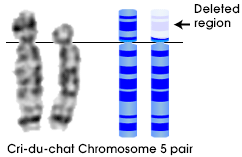|
Links |
Initial Discovery and Clinical Aspects | |||||||||||||||||||||||||||
|
Initial Discovery and Clinical Aspects Molecular/Biochemical Properties and Characteristics of Cri Du Chat-Related Proteins Links to Cri Du Chat Support Groups
|
Initial Discovery Cri du Chat Syndrome (CdCS) was first described c by J. Lejeune et al., in 1963 as a genetic, chromosomal disease that resulted from the deletion of variable sizes in the short arm of chromosome 5 (Orphanet). Deletions can range from a small size only involving the 5p15.2 sub-band to the entire short arm of the chromosome (OMIM). Due to the variability of the deletion, multiple, congenital anomalies were observed to develop in the phenotype, ranging from a distinctive cat-like cry to additional growth, facial, and mental abnormalities.
Clinical Aspects ▪ CdCS is a rare genetic disease that occurs in a range from 1:15,000 to 1:50,000 of live-born infants. However, CdCS is perhaps the most frequent autosomal deletion syndrome to occur in humans. In Niebuhrís series, mortality transpires in 10% of all patients, 90% of which occur before or within the first year of life.
▪ Because of the variability of the deletion that occurs in the 5p arm, numerous abnormalities exist in the phenotype of this syndrome. These abnormalities include:
▪ Developmental symptoms also exist with children diagnosed with Cri du Chat syndrome. These children often have feeding problems due to swallowing difficulties, as well as failure to thrive as a child. They also have delays in their speech and motor skill development. Recurring intestinal, respiratory, and ear infections are observed as well.
▪ Behavioral Symptoms also develop into the phenotype of Cri du Chat-diseased children. These children often have hyperactivity, aggression, tantrums, stereotypic and self-injurious behavior, repetitive movements, hypersensitivity to sound, clumsiness, and obsessive attachments to objects. These characteristics, however, usually depend on the cognitive-ability of the child, which is related to the variability of the chromosomal deletion. Features similar to those of autism and social withdrawal have also been observed, however theses symptoms may be more characteristic of individuals who have a 5p deletion as the result of an unbalanced segregation of a parental translocation.
|

